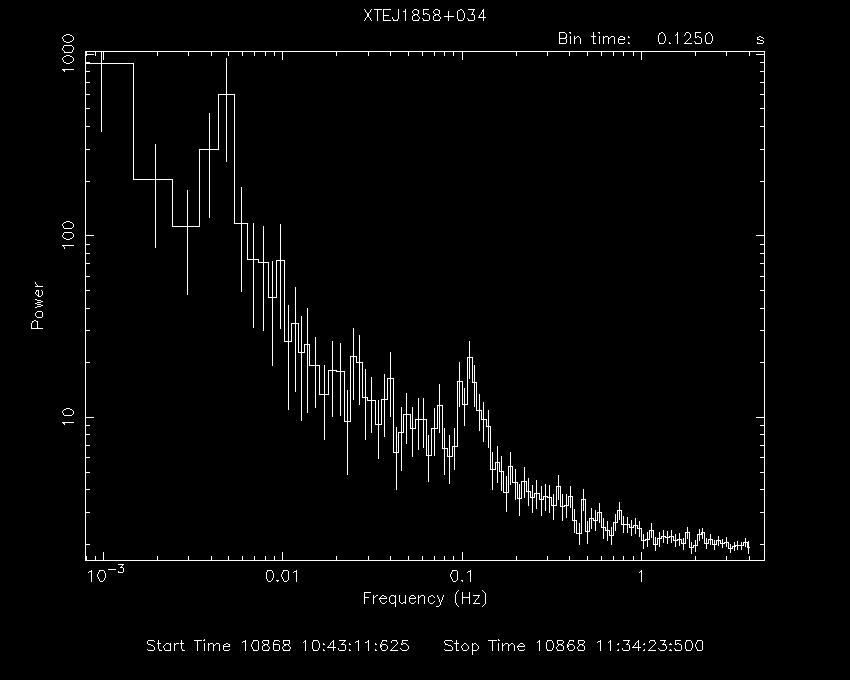Timing Analysis: Exercise 7
Quasi Peridic Oscillations in X-ray Pulsars
We have seen in all the previous exercises that the signals present in
the data are strictly periodic. The fourier transform of such periodic signals
are almost like delta functions, which gives a sharp peak in the power
density spectrum. But this is not the case always, there are some signals
which are not strictly periodic and are called Quasi Periodic Oscillations
or in short QPOs. Since these are not periodic signals, the fourier
transform of such signals is not a delta function. Instead it shows a broad
peak in the power density spectrum. Often the amplitude of the signal of
a QPO is comparatively smaller than the amplitude of a periodic signal and
spread
over a frequency range making it hard to detect.
We can use the same task
powspec
to search for QPOs present in the data. The data we are going to analyze
for this exercise is taken from PCA instrument on board RXTE satellite for
a pulsar XTE J1858+034
.
Copy the light curve InvokeXTE_J1858+034_pca.lc
and invoke the task powspec by giving the command at the
prompt.
pulsar> powspec
powspec 1.0 (xronos5.18)
Ser. 1 filename +options (or @file of filenames +options)[file1] XTE_J1858+034_pca.lc
Series 1 file 1:XTE_J1858+034_pca.lc
Selected FITS extensions: 1 - RATE TABLE;
Source ............ XTEJ1858+034 Start Time (d) .... 10868 10:43:11.562
FITS Extension .... 1 - `RATE ` Stop Time (d) ..... 10868 11:37:03.562
No. of Rows ....... 25856 Bin Time (s) ...... 0.1250
Right Ascension ... 2.84730011E+02 Internal time sys.. Converted to TJD
Declination ....... 3.41000009E+00 Experiment ........ XTE PCA
Corrections applied: Vignetting - No ; Deadtime - No ; Bkgd - No ; Clock - Yes
Selected Columns: 1- Time; 2- Y-axis; 3- Y-error; 4- Fractional exposure;
File contains binned data.
Name of the window file ('-' for default window)[-] -
Expected Start ... 10868.44666160222 (days) 10:43:11:562 (h:m:s:ms)
Expected Stop .... 10868.48406900962 (days) 11:37: 3:562 (h:m:s:ms)
**** Warning: Newbin Time must be an integer multiple of Minimum Newbin Time
Minimum Newbin Time 0.12500000 (s)
for Maximum Newbin No.. 25857
Default Newbin Time is: 0.50000000 (s) (to have 1 Intv. of 8192 Newbins)
Type INDEF to accept the default value
Newbin Time or negative rebinning[0.125] 0.125
Newbin Time ...... 0.12500000 (s)
Maximum Newbin No. 25857
These inputs are very similar to that supplied in Exercise-2. You give
the appropriate file name containing light curve, default window file and
newbin time which is integer multiple of the minimum newbin time.
Default Newbins per Interval are: 8192
(giving 4 Intervals of 8192 Newbins each)
Type INDEF to accept the default value
Number of Newbins/Interval[8192] 8192
Maximum of 4 Intvs. with 8192 Newbins of 0.125000 (s)
Default intervals per frame are: 4
Type INDEF to accept the default value
Number of Intervals/Frame[4] 4
Results from up to 4 Intvs. will be averaged in a Frame
We have used the default number of newbins per interval (i.e. 8192) which
will give us total of 4 intervals per frame. In the following we use a geometric
rebinning to plot the data. This gives a better appearance to the
result.
Rebin results? (>1 const rebin, <-1 geom. rebin, 0 none)[-1.05] -1.05
Results will be rebinned geometrically with a series of step 1.05
Name of output file[default]
Do you want to plot your results?[yes]
Enter PGPLOT device[/XW]
4096 analysis results per intv. will be rebinned to 109
31% completed
Intv 1 Start 10868 10:43:11
Ser.1 Avg 291.3 Chisq 0.1233E+05 Var 3507. Newbs. 8192
Min 112.0 Max 552.0 expVar 2330. Bins 8192
Power spectrum ready !
Intv 2 Start 10868 11: 0:15
Ser.1 Avg 299.2 Chisq 0.1224E+05 Var 3578. Newbs. 8192
Min 104.0 Max 624.0 expVar 2394. Bins 8192
Power spectrum ready !
Intv 3 Start 10868 11:17:19
Ser.1 Avg 325.0 Chisq 0.1479E+05 Var 4696. Newbs. 8192
Min 120.0 Max 688.0 expVar 2600. Bins 8192
Power spectrum ready !
100% completed
Intv 4 Start 10868 11:34:23
Ser.1 Avg 356.7 Chisq 2043. Var 4554. Newbs. 1280
Min 160.0 Max 608.0 expVar 2853. Bins 1280
Interval rejected because of window(s) in series 1 !
The power spectrum will look like as shown below.

You can clearly see a broad peak at the frequency of about 0.1 Hz. This
indicates the presence of 0.1 Hz QPO in the source XTE J1858+034. Also
the amplitude of the QPO is relatively small.
This pulsar has a spin period of 221 s and also gives a quasi-periodic
signal of 0.11 Hz. The quasiperiodic
signal is most likely related to some phenomena in the accretion disk.
|


